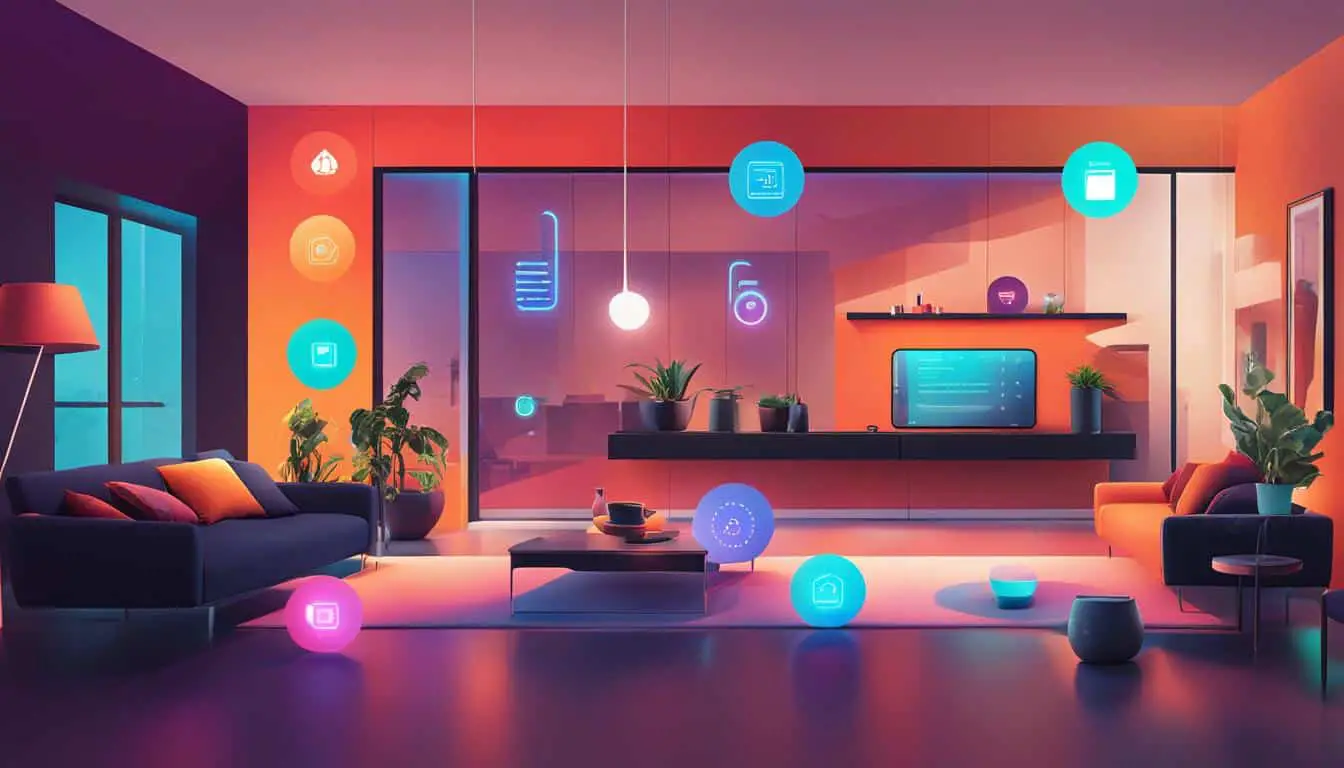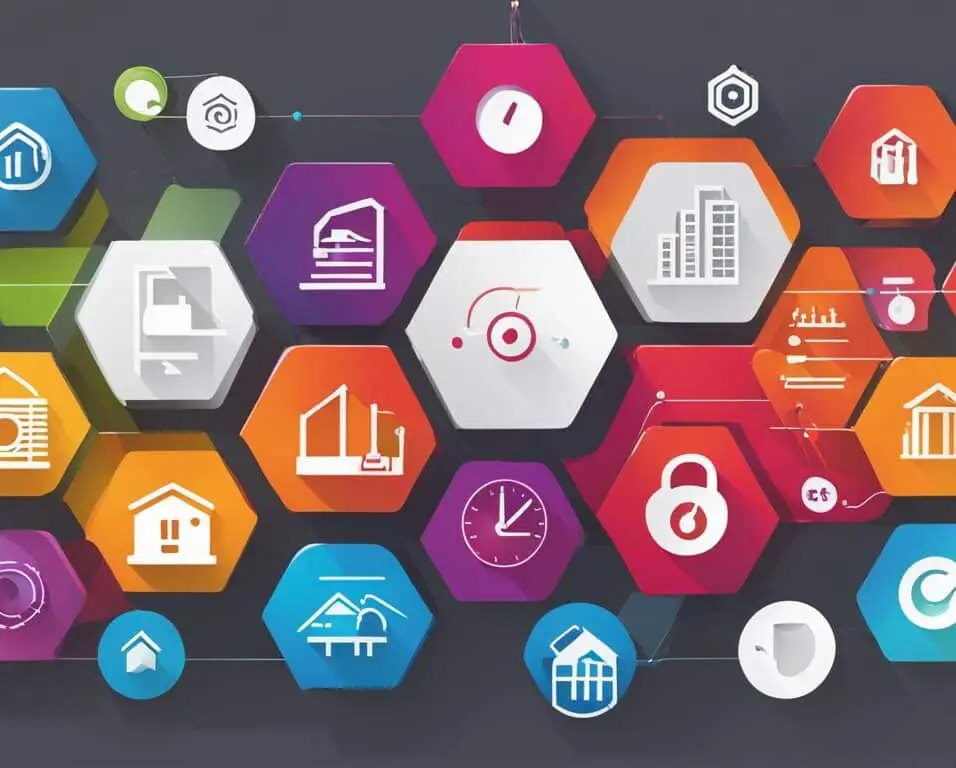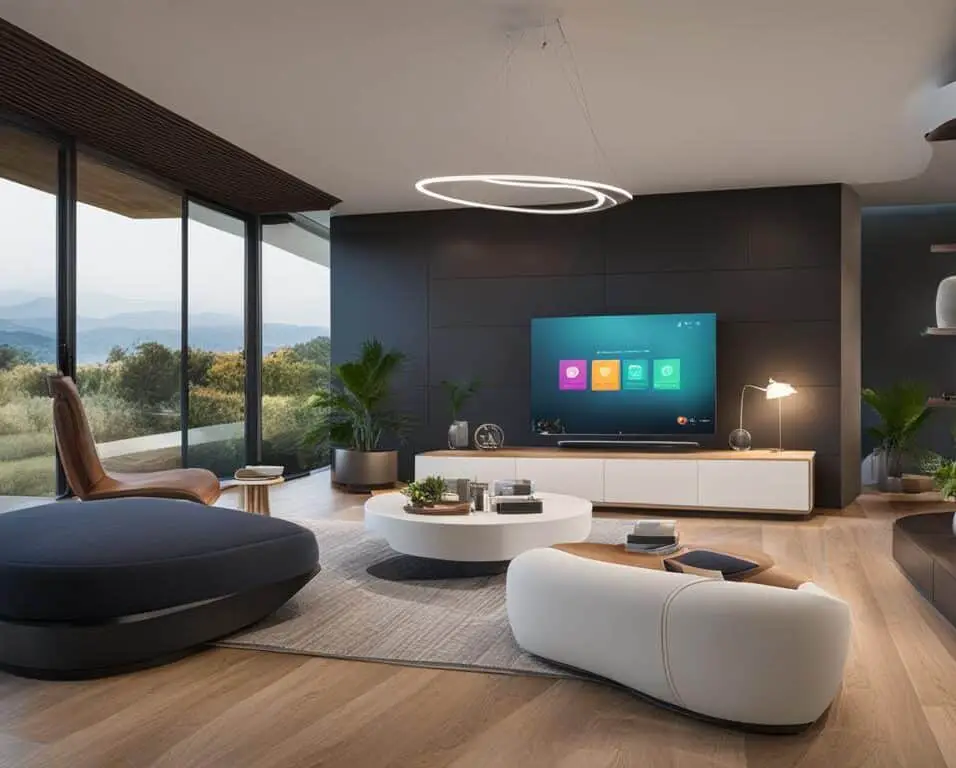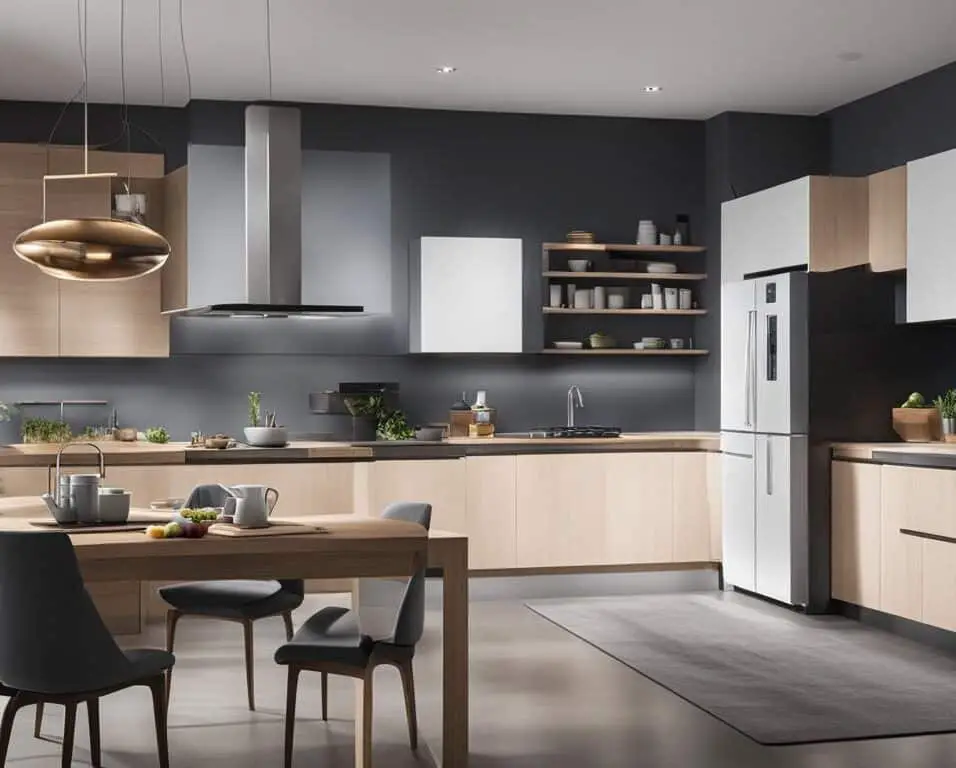Seamless Home Automation Through IoT
IoT devices and home automation solutions have revolutionized the way we live, offering seamless integration of technology into our homes. The combination of Python programming language and IoT technologies has played a pivotal role in driving this transformation. With the use of IoT-enabled devices, homeowners can now control and manage various aspects of their homes, leading to increased efficiency, convenience, and security. The integration of Python and IoT brings a wide range of advantages, including ease of use, extensive library support, and versatility. By leveraging the potential of Python and IoT, smart home solutions can be customized to meet individual needs and preferences, enhancing comfort and well-being in our daily lives.
Key Takeaways
- IoT devices and home automation provide seamless integration of technology into our homes.
- The combination of Python programming language and IoT enables homeowners to control and manage various aspects of their homes.
- The integration of Python and IoT brings advantages such as ease of use, extensive library support, and versatility in smart home solutions.
- By leveraging Python and IoT, smart home solutions can be customized to meet individual needs and preferences.
- Python and IoT revolutionize home automation, leading to increased efficiency, convenience, and security in our daily lives.
The Evolution of Smart Homes
Smart homes have come a long way since the concept of home automation emerged in the late 1970s. With rapid technological advancements, our expectations of smart homes have evolved, going beyond mere convenience to encompass comprehensive control and access to various home appliances and systems.
In the past, wired communication systems like Arduino and Raspberry Pi were common in home automation. However, the introduction of wireless systems utilizing technologies such as Bluetooth, Wi-Fi, and IoT has made home automation more accessible and cost-effective. These wireless systems have also improved comfort and energy efficiency in both newly constructed buildings and retrofitted structures.
Comparing Wired and Wireless Systems in Smart Home Automation
| Wired Systems | Wireless Systems |
|---|---|
| Require extensive wiring installation | Eliminate the need for complex wiring |
| Less flexible in terms of device placement and relocation | Allow for easy device placement and relocation |
| Often more expensive due to installation costs | Cost-effective and scalable |
| Suitable for retrofitting existing homes | Ideal for both new construction and retrofits |
| Require professional assistance for installation | Can be easily set up by homeowners |
Wireless systems in smart homes have revolutionized the way we approach home automation. By leveraging technologies like Bluetooth, Wi-Fi, and IoT, homeowners can now enjoy the benefits of seamless integration without the need for extensive wiring installations and professional assistance. This shift toward wireless systems has not only increased accessibility but has also allowed for greater flexibility and cost-effectiveness in implementing smart home solutions.
With the continued advancements in IoT technology, we can expect smart homes to become even more sophisticated, offering enhanced control and customization options. From managing lighting and climate control to monitoring security systems and optimizing energy usage, the evolution of smart homes driven by wireless systems and IoT technology promises a future where homes are truly interconnected and adaptive to our needs.
What is Python and IoT?
Python is a versatile and highly readable programming language that has gained significant traction in the realm of IoT. Paired with IoT devices, Python allows users to control and manage various aspects of their homes through a unified interface. Python’s ease of use and extensive library support make it an ideal choice for beginners venturing into IoT development. With its concise syntax and a rich set of libraries like Flask and Django, Python enables developers to rapidly prototype ideas and create innovative smart home solutions. The fusion of Python and IoT provides countless possibilities for tailoring intelligent living spaces to individual needs and preferences.

Why is Python suitable for IoT development?
Python’s simplicity and readability make it particularly well-suited for IoT development. With its clear and concise syntax, Python allows developers to write clean and understandable code that can be easily maintained. Additionally, Python’s extensive library support provides a wide range of pre-built functions and modules that simplify and expedite the development process.
When it comes to IoT applications, Python offers unparalleled ease of use and versatility. Its integration with IoT devices allows seamless control and management, empowering users to optimize their smart homes according to their preferences. The rich set of libraries, such as NumPy, Pandas, and Matplotlib, facilitate complex data processing and visualization, enabling intelligent decision-making based on real-time information.
Benefits of Python and IoT integration in smart home control
1. Ease of use: Python’s beginner-friendly syntax and clear structure make it accessible for developers of all skill levels. This ease of use opens up the world of IoT development to a wider audience, fostering innovation and creativity in the realm of smart home control.
2. Rich set of libraries: Python offers a vast array of libraries specifically designed for IoT applications, providing ready-made solutions for common tasks and enabling developers to focus on implementing unique features and functionalities.
3. Versatility: Python’s cross-platform compatibility allows applications to seamlessly run on different hardware platforms and operating systems, providing flexibility and scalability in IoT solutions.
4. Rapid prototyping: Python’s agility and extensive library support enable developers to quickly create prototypes and iterate on their ideas. This reduces development time and facilitates the exploration of innovative smart home control concepts.
Python Libraries for IoT Development
| Library Name | Description |
|---|---|
| Flask | A micro web framework for building web applications, allowing seamless communication between IoT devices and the user interface. |
| Django | A high-level Python web framework that provides a robust set of features for building secure and scalable IoT applications. |
| PySerial | A library for serial communication, enabling Python programs to interact with serial ports and devices connected to them. |
| OpenCV | A library for computer vision and image processing, offering advanced functionalities for analyzing visual data captured by IoT devices. |
The Intersection of Python and IoT
The intersection of Python and IoT has ushered in a new era of intelligent living spaces, revolutionizing the way we experience our daily lives. With the simplicity and readability of Python programming language combined with the power of IoT technology, the possibilities for automation, convenience, and future innovation are boundless.
Python’s user-friendly syntax and comprehensive library support make it an ideal language for IoT development. Its versatility allows seamless integration with a wide range of devices, enabling efficient communication and control among interconnected devices in a smart home environment.
Through Python and IoT integration, we can experience the convenience of automating various tasks within our homes. From controlling lights and thermostats to managing security systems, Python enables us to customize and personalize our living spaces based on our individual preferences.
In creating these intelligent living spaces, Python and IoT provide the foundation for a future where our homes anticipate our needs and seamlessly adapt to our lifestyles. This harmonious integration unlocks limitless possibilities, enhancing convenience, comfort, and efficiency in ways we never thought possible.
As we look ahead, the future of Python and IoT integration holds immense promise. Imagine a home where our devices work together seamlessly, optimizing energy usage, maximizing convenience, and learning from our habits to create personalized experiences. The potential for creating truly connected and automated homes is truly exciting.
The Benefits of Python and IoT Integration:
- Automation: Python, combined with IoT devices, allows for the automation and control of electronic devices, streamlining daily tasks and enhancing convenience.
- Intelligent Living: By integrating Python and IoT, we can create intelligent living spaces that adapt to our preferences and anticipate our needs, truly enhancing the way we live.
- Convenience: The seamless communication and control capabilities of Python and IoT technology enable us to easily manage various aspects of our homes, providing a new level of convenience in our daily lives.
- Future Possibilities: The possibilities for Python and IoT integration are vast, offering a future where our homes become increasingly intuitive and efficient, addressing our needs and enhancing our well-being.

With Python and IoT integration, the future of smart homes is bright. By leveraging the power of Python’s simplicity and IoT’s functionality, we can create a truly intelligent and connected living environment that brings us closer to a seamless, automated, and convenient lifestyle.
The Advantages of Using Python in IoT Applications
Python offers numerous advantages for IoT development. Its versatility allows seamless integration with different hardware platforms and operating systems, making it possible to create cross-platform applications that can run on various devices. Python’s cross-platform compatibility ensures that developers can build IoT solutions that can be deployed on Windows, Mac, Linux, and other operating systems without any major modifications.
One of the key strengths of Python lies in its extensive library support. The Python programming language provides a rich ecosystem of libraries and frameworks specifically designed for IoT development. These libraries, such as NumPy, Pandas, and Matplotlib, simplify complex data processing tasks in IoT applications. With these tools at their disposal, developers can handle data analysis, visualization, and manipulation with ease, enabling the creation of intelligent solutions.
“Python’s versatility and extensive library support make it an ideal choice for IoT development.”
Python also excels in facilitating effective data exchange between IoT devices. It provides extensive support for popular communication protocols like MQTT (Message Queuing Telemetry Transport) and CoAP (Constrained Application Protocol). These protocols enable efficient and secure data transfer between devices, ensuring seamless connectivity and interoperability in IoT applications.
Furthermore, Python frameworks like Django and Flask streamline web application development for managing the interface between users and IoT devices. These frameworks provide robust tools for creating responsive web interfaces, handling user inputs, and integrating with IoT platforms, enhancing the overall user experience.
Python’s inherent advantages, combined with a thriving community, make it an exciting choice for revolutionizing homes using IoT systems. Developers can leverage the extensive documentation, active forums, and open-source contributions, ensuring support and continuous improvement of Python for IoT development.
Advantages of Python in IoT Applications:
- Seamless integration with different hardware platforms and operating systems
- Extensive library support for simplified data processing
- Efficient data exchange through support for popular communication protocols
- Streamlined web application development with frameworks like Django and Flask
- Engaged community for support and continuous improvement of Python
By harnessing the power of Python programming language, developers can create innovative and efficient IoT applications that enhance our daily lives. The combination of Python’s versatility, extensive library support, and cross-platform compatibility make it the ideal choice for building intelligent and interconnected solutions in the rapidly evolving IoT landscape.
Conclusion
Integrating IoT devices into our homes has transformed the way we live, bringing efficient smart home solutions within reach. By harnessing the power of IoT technologies and the versatility of the Python programming language, homeowners can achieve seamless home automation and control. The evolution of smart homes and the integration of Python and IoT have unlocked countless possibilities for enhancing convenience, comfort, and efficiency in our daily lives.
With Python and IoT, we can now easily control lighting and temperature, manage security systems, and optimize energy usage. By customizing our intelligent living spaces, we prioritize our comfort and well-being. The potential for creating a truly connected and automated home is unmatched.
As we look to the future, the possibilities of home automation, IoT technologies, and Python programming language hold immense potential for innovation. By embracing this integration, we can unlock the benefits of a smarter, more efficient, and personalized home. Whether it’s improving energy efficiency, enhancing comfort, or streamlining everyday tasks, the combination of Python and IoT offers homeowners the opportunity to create their dream smart homes. Through the power of technology, we can revolutionize our homes and truly live in a connected world.
FAQ
What is home automation?
Home automation refers to the integration of technology into homes to enable the control and management of various aspects, such as lighting, temperature, security systems, and energy usage, through a unified interface.
How do IoT devices contribute to home automation?
IoT devices play a crucial role in home automation by providing connectivity and communication between different devices and systems within a smart home. They enable homeowners to remotely control and manage their homes using smartphones or other devices.
Why is Python programming language widely used in IoT development?
Python is a versatile and highly readable programming language that offers extensive library support and ease of use. These qualities make Python ideal for beginners venturing into IoT development and enable rapid prototyping of smart home solutions.
What are the advantages of integrating Python and IoT in smart homes?
The integration of Python and IoT brings numerous advantages, including the ability to customize smart home solutions, extensive support for different hardware platforms and operating systems, and simplified web application development for managing the interface between users and IoT devices.
How does Python contribute to cross-platform compatibility in IoT applications?
Python’s versatility enables seamless integration with different hardware platforms and operating systems. This ensures that IoT applications developed using Python can run on various devices, irrespective of their underlying technology.
What are some of the key benefits of using Python in IoT applications?
Python offers extensive library support, such as NumPy, Pandas, and Matplotlib, which simplify complex data processing tasks in IoT applications. Python also provides support for popular communication protocols like MQTT and CoAP, facilitating effective data exchange between IoT devices.
How can IoT devices enhance the convenience and efficiency of a smart home?
IoT devices enable homeowners to remotely control and manage various aspects of their homes, such as lighting, thermostats, security systems, and energy usage. This enhances convenience, comfort, and energy efficiency, leading to a more efficient lifestyle.








